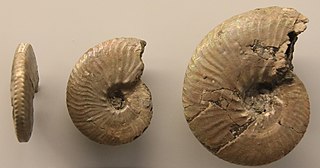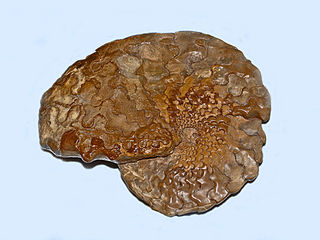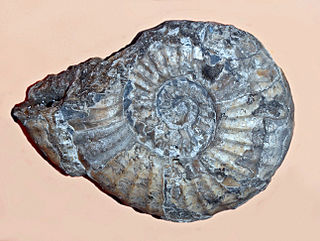
Euhoplites is an extinct ammonoid cephalopod from the Lower Cretaceous, characterized by strongly ribbed, more or less evolute, compressed to inflated shells with flat or concave ribs, typically with a deep narrow groove running down the middle. In some, ribs seem to zigzag between umbilical tubercles and parallel ventrolateral clavi. In others the ribs are flexuous and curve forward from the umbilical shoulder and lap onto either side of the venter.

Anahoplites is a genus of rather involute, compressed hoplitid ammonites with flat sides, narrow flat or grooved venters, and flexious ribs or striae arising from weak umbilicle tubercles that end in fine dense ventrolateral nodes. The elements of their sutures are short, wide and jaggedy. Specimens of Annahoplites have diameters typically in the range of 4–6 centimetres (1.6–2.4 in) although some with diameters of as much as 19 centimetres (7.5 in) have been reported. The genus lived during the Cretaceous, from the Middle to the late Albian.
Frechiella is an ammonite with a smooth, somewhat globose involute shell that lived during the later part of the Early Jurassic, which has been found in England and Italy. The shell is coiled so that the outer whorls cover most of the inner, leaving the inner whorls only slightly exposed. The outer rim, known as the venter, is broadly arched, with either a low narrow keel bordered by small grooves, or a large median groove.
Fournierella is a member of the Muniericeratidae, a family of Upper Cretaceous ammonites characterized by moderately evolute shells with strong sinuous ribs that have tubercles on the shoulders and umbilical edge, and a more or less fastigate cross section, included in the Desmocerataceae. It may be a subgenus of Pseudoschloenbachia.
Zurcheria is a genus of dwarf ammonites from the Middle Jurassic included in the Hammatoceratidae and lacking a keel. The shell is evolute, inner whorls exposed; whorls compressed and slightly overlapping. Bears ribs, which are sinuous folds that project strongly onto the arched venter.

Uptonia is an extinct ammonite from the Lower Jurassic that's included in the eoderoceratoidean family Polymorphitidae.

Ammonitina comprises a diverse suborder of ammonite cephalopods that lived during the Jurassic and Cretaceous periods of the Mesozoic Era. They are excellent index fossils, and it is often possible to link the rock layer in which they are found to specific geological time periods.
Fissilobiceras ist ein glatter, komprimierter, involuter Ammonit aus dem unteren mittleren Jura (Aalenium/Bajocium) Europas, der 1919 von Buckman benannt wurde. Fissilobiceras gehört zur Familie der Hildoceratoiden (Hammatoceratidae).
Haplopleuroceras is a Middle Jurassic ammonite and likely member of the Hildoceratacean family Sonniniidae with which it shares the same sort of ribbing.

Peltoceras is an extinct ammonite genus from the aspidoceratid subfamily Peltoceratinae that lived during the later part of the Middle Jurassic.

Tissotiidae is a family of ammonites (Ammonitina) belonging to the Acanthoceratoidea.

Arietitidae is a family of true ammonites that make up part of the superfamily Psiloceratoidea, named after the type genus Arietites. They comprise medium-size to large or gigantic genera which in general are strongly ribbed, tuberculate in some, with keeled or grooved and keeled venters, and well differentiated ammonitic sutures. The aptycus is single valved with a shiny, concentrically striated surface.

Kepplerites is a moderately evolute ammonite from the lower Callovian included in the Stephanoceratoidea.

Stoycho Vassilev Breskovski was a Bulgarian paleontologist.

Hauericeras is an ammonite genus from the Late Cretaceous that lived from the Coniacian to the late Maastrichtian, from about 90 to 66 mya. Fossils have been found in Europe, Russia, South Africa, Australia, India, Iraq, and in the United States.
Leymeriellidae is an extinct family of Lower Cretaceous ammonites comprising rather small forms distinguished from Hoplitidae by their flattened and grooved ribs and virtual absence of umbilical tubercles. The family is derived from the Desmoceratidae. Leymeriella schrammeni anterior has evolved from Desmoceras keilhacki keilhacki.
Melchiorites is a desmoceratid ammonite genus included in the subfamily Puzosiinae. Member species are characterized by an essentially evolute shell in which the early whorls are smooth, with sinuous radial or oblique constrictions but in which later whorls have feeble intermediate ribs on the outer part of the sides and venter.
Tragodesmoceras is a large moderately involute ammonite with deeply embracing whorls that are higher than wide, a steep sided umbilicus and a narrowly rounded venter. Ornament consists of primary ribs that begin at the umbilical shoulder and smaller secondary ribs that begin mid flank. Ribs are sigmodal, periodically thickened and bent forward on the outer flank to cross the venter as chevrons. The suture has a broad trifid lateral lobe.

Hammatoceratidae is a family of lower and middle Jurassic ammonites included in the superfamily Hildoceratoidea.

Hammatoceras is a genus of ammonites belonging to the family Hammatoceratidae which lived during the Toarcian stage of the Early/Lower Jurassic between about 184 and 175 million year ago.










